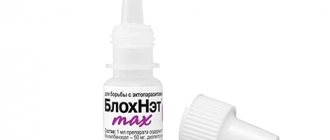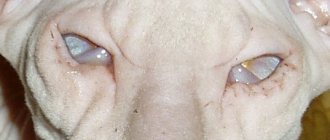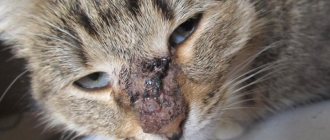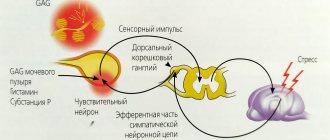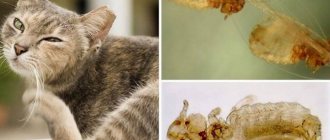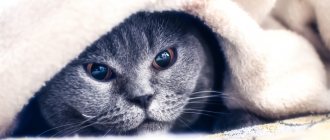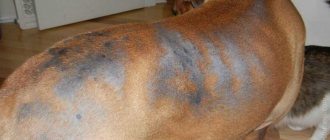27.08.2019
Skin diseases in cats
no comments
5241
Cat chin acne is a common skin condition in the feline species. To be more precise, this is the most common manifestation of acne in cats. It can appear at any age and the gender of the animal does not matter. The disease can get worse, worse, or even be extremely difficult to treat. Signs and symptoms range from barely noticeable comedones (blackheads) to severely inflamed and debilitating pustules. Some cats are not bothered at all, while for others, the pimples are very itchy and painful. Localized hair loss and skin redness are also common.
What is acne and what are the causes
Acne, which affects felines, is a skin disease. It develops due to the appearance of inflammatory processes in the sebaceous glands. Most often, the symptoms of this disease appear in the lower part of the muzzle (lip, mouth and chin). But in rare cases, signs of this disease can be found in other parts of the body, since in cats the sebaceous glands are scattered over the entire surface of the skin.
Scientists cannot yet say exactly what causes the development of this disease. However, there are the following factors that can cause the development of acne:
- the presence of skin diseases of any etiology;
- severe stress. It negatively affects the functioning of the sebaceous glands, leading to excessive production of sebum;
- abnormal structure of both hair follicles and sebaceous glands;
- reduced immunity;
- food from a plastic bowl. Due to the characteristics of the material, such products create excellent conditions for the development of microbes.
Signs of acne usually appear in places where the animal is not able to provide proper hygiene care on its own: the nose, lips, mouth and chin. That is why the owner himself needs to periodically wash these places.
No relationship was found between the development of this disease and age, gender or breed. Moreover, some cats get anke once - their symptoms go away on their own, without relapses. Other animals constantly suffer from acne on the lower part of the muzzle. In this case, the risk of concomitant secondary infections is very high.
Causes of acne in cats
There is no exact etiology of what exactly causes feline acne. Veterinarians have identified factors that provoke the disease:
- Hereditary or acquired skin problems can give impetus to the development of the disease. Acquired diseases include damage to the subcutaneous demodex mite, dermatophytosis, various viral infections, contact and atopic dermatitis;
- Problems in the development of hair follicles;
- Pathologies of the sebaceous glands, hyperfunction of the sebaceous glands;
- Hormonal imbalance in the pet’s body;
- Diseases of the gastrointestinal tract or liver;
- Lack of necessary hygiene care. Owners often wonder why their cat's chin is sore. The problem lies in the inaccessibility of this place for thorough washing: the cat is not able to lick its chin, so possible small food debris or fat can cause acne;
- Reduced immune defense of the body;
- Stress leads to disruption of the sebaceous glands, which consequently produce more secretion than required;
- Using plastic bowls to feed the cat (plastic has pores in which bacteria collect; this is especially dangerous if such bowls, even from under water, are rarely washed);
- Anti-parasitic or regular collars can cause allergies, resulting in irritation.
Under certain conditions, black spots can appear in both kittens and older cats. According to veterinarians, sphinxes are more often susceptible to acne: in hairless and curly-haired pets, the disease occurs in a severe form, since sparse hair or its absence contributes to blockage of the ducts. White cats are also more prone to skin lesions. Unlike uncastrated pets, castrated cats and sterilized cats rarely, in isolated cases, go to see a veterinarian with this problem.
Symptoms and diagnosis
The main symptom of this disease is black spots in the cat’s fur. Each such point is an acne, which without treatment can transform into an ulcer. Blackheads most often appear on the beard. But they can also be found in much smaller quantities near the mouth and nose.
At first, the dots resemble dirt, which is easily removed when bathing. Such symptoms are characteristic of the initial stage of the disease. Without treatment, the cat's condition will worsen due to infection entering the clogged pores. As a result, the skin will begin to become inflamed and red, forming spots of varying sizes.
Next, the hair follicles fill with pus, transforming into comedones (a lump or cyst that appears due to blockage of the follicle). May be pea or grain shaped. Still immature abscesses are hot and dense to the touch. When you press them, the cat experiences discomfort (irritation or even aggression) and pain.
A mature abscess has a black or white head. When pressed, its contents come out. Sores appear at the site of the breakouts. In young animals they quickly become crusty. Older pets may develop scabs with pus discharge.
When wounds become infected, complications develop: necrosis of the sebaceous gland, scars, bald patches, etc.
Therefore, if the animal has the initial symptom of the disease (black spots and pimples), it is necessary to immediately show the pet to the doctor for diagnosis and initiation of treatment. Correct diagnosis is important, since many skin sores have a similar symptomatic picture: scabies, allergies, dermatophytosis, etc.
The veterinarian performs an external examination of the animal and also prescribes laboratory tests (scraping, blood test and skin biopsy). The doctor may also check the functioning of the digestive organs (such as the liver) through a metabolic assessment.
Where can acne appear in cats?
For experienced cat lovers, rashes can look like waste products of parasites, so you need to figure out what the cause of blackheads is. If they cannot be brushed off or quickly cleaned, it means they are deep in the pores and have nothing to do with parasites. Where can you most often see them?
Acne on a cat's chin is the most common location. The pet often scratches its chin, rubs it against objects both inside and outside the house, thereby introducing a secondary infection and injuring itself even more. In addition, it is this part that is least accessible for washing, and therefore least protected from infection. The affected area of the chin looks dry and flaky, with local hair loss, with characteristic acne and redness.
The muzzle is the calling card of a cat. Among the things that the animal usually rubs against at home are furniture legs, corners of sofas, baseboards and, of course, toys. This behavior is dictated by a sense of security, since the cat leaves its scent on those things that it recognizes as personal. Therefore, a cat's face has the second highest risk of acne. Characteristic rashes occur around the lips and near the ears above the eyes.
The glands, which play the role of a business card, are present not only on the head, but also at the base of the tail. Due to their constant work, hair follicles secrete a certain secretion. When it settles on the skin and fur, it can lead to acne around the tail.
Rashes are much less common on other parts of the body. These areas are characterized by short hair or hairless areas - for example, around the nipples, in the armpits, near the genitals, between the fingers, in the groin.
Treatment
Treatment of acne in domestic cats is carried out in several ways:
- medications;
- folk remedies;
- diet.
Let's consider each method separately.
Complex therapy is often used, which combines all three treatment options. This approach is considered the most effective.
Medication
First, the affected areas of the skin are washed with tar shampoo. They are then treated with hydrogen peroxide and lubricated with salicylic acid. Afterwards, an ointment with a bactericidal effect is applied to the pimples. This is enough to cleanse the skin of blackheads.
Ulcers are treated with an antibiotic (for example, Bactroban). Together with them, you should use ointments containing vitamin A.
Folk remedies
Among the folk remedies used to combat acne are:
- decoction of calendula and chamomile flowers. It is mixed with 2 tablets of Furacilin. The skin is treated 2 times a day;
- freshly cut pieces of pumpkin. They wipe the rash 2-3 times a day;
- decoction of celandine. To prepare the product, add 4 tbsp to 6 glasses of water. l. herbs. The broth is boiled for 5 minutes. Lotions are made from it 2-3 times a day;
- yarrow decoction. Brew 1 tsp in a glass of water.
Main symptoms
In the early phase, acne appears as black dots, which can be confused with dirt or sand in the fur. If you do not pay attention to the changes that have arisen in your pet’s appearance, then the next phase will be redness of the skin and swelling of the affected area.
The pet begins to itch, wounds with bloody discharge may appear at the site of scratching, and if the cat is not treated at the initial stage, the skin disease will progress and reach the appearance of ulcers, and in some cases, to patchy baldness.
If symptoms of itching, restlessness and skin rashes appear in your pet, you should immediately contact a veterinary clinic to have your animal examined.
Importance of diagnosis
Under no circumstances should you conduct a diagnostic examination of your pet yourself. It is best to entrust this matter to veterinarians. The clinical picture characteristic of acne is similar to diseases such as dermatomycosis, scabies mites and allergic reactions.
If carefully examined, pimples on the chin may turn out to be dirt or insect bites. To determine the causes of acne, it is necessary to scrape the lesions. Microscopic examination of the material allows you to accurately determine the causes of the disease and prescribe the correct treatment.
Diet
A properly formulated diet can not only strengthen the cat’s immune system, but also prevent the appearance of acne. Daily food should contain a large amount of vitamins and micronutrients. The diet of cats should contain foods rich in tocopherol, ascorbic acid and vitamin A. The listed elements help protect pets from various infectious and dermatological diseases.
In order to normalize metabolism and the functioning of the sebaceous glands, it is necessary to feed cats porridge. Slow carbohydrates contained in cereals speed up metabolism and improve local immunity . It is not recommended to feed animals fatty foods, canned food and sausage. These products negatively affect the condition of the liver and the production of subcutaneous fat.
Prevention of acne in cats
The task of any owner is to provide proper care for his mustachioed friend. Thus, water and food bowls should be washed once a day and new food should not be added to a plate with old food.
Drinking water should always be fresh. If your pet has a tendency to form black spots, then after each meal you need to wipe its face.
Blackheads in cats usually affect the chin and areas around the mouth. Most owners do not attach importance to this skin disease, hoping for their pet to heal on its own. But lack of attention to this pathology can lead to serious problems. In order not to aggravate the situation, the owner must know the causes and methods of treating blackheads.
The article is for informational purposes only. Contact your veterinarian!
Nature of the disease
The structure of the skin of the cat family is very similar to the structure of human skin. These similarities suggest that many cats experience the same dermatological conditions as humans. The most common skin disease is acne.
The location of the rash blisters on the surface of the skin depends on the location of the sebaceous glands. Most often, symptoms characteristic of acne are observed in cats in the area of the ears, abdomen and ribs. The appearance of a small cluster of pimples in the chin area is the most common occurrence . This problem does not pose a risk to the health of the pet. In most cases, such symptoms are only temporary and do not in any way affect the functioning of internal organs.
Among the negative consequences of acne, one should highlight the loss of aesthetic appeal due to disturbances in the process of sebaceous secretion production. The main danger of this problem is the high risk of developing dermatitis. With this disease, small ulcers form on the surface of the skin. If the cat begins to scratch the lesions, the situation may be complicated by the addition of a secondary infection.
Where can cat acne appear?
Acne most often appears on the chin in cats, although sebaceous glands are located throughout the body.
Even the most caring owners do not always immediately notice spots on the cat’s face, but later the acne localization expands - first red and then black dots appear::
- on the elbow bends of the paws;
- on the ears;
- under the tail.
You should immediately contact a veterinarian if individual spots turn into large scatterings and become covered with crusts.
When an animal is concomitantly infected, the cat may experience itching, actively scratch its body, hair falls out, and the affected area swells.
At-risk groups
Veterinarians believe that the appearance of acne is not related to the breed, age or gender of the pet. Pathologies can be either isolated or regular, cyclical, depending on the cause of the disease.
Statistics show that castrated and sterilized animals are less susceptible to the disease, but even in this case its occurrence is not excluded.
Most often, acne appears repeatedly in cats, so it is important to completely cure the animal the first time acne appears.
In individuals with long hair, lesions may appear on the face and in the folds of the skin. The only exception is hairless cats (Sphynxes), due to greater sebum secretion than other breeds, these animals have a higher risk of acne. Careful care helps eliminate the risk of pathology.
Preventive measures
An advanced form of the disease can lead to serious complications. Based on this, it is very important to start treatment of the disease in a timely manner. In order to reduce the risk of acne formation, preventive measures should be taken carefully.
In order to prevent recurrence of acne, you should wash the dishes from which the animal eats as often as possible. The water in the bowl should be changed at least twice during the day. After your pet eats, you need to wipe the chin with a napkin soaked in warm water. In order to normalize the functioning of the sebaceous glands, you should remove all fatty foods from your diet. In order to strengthen your pet's immune system, you should feed it healthy food rich in vitamins.
Diagnosis of cat acne on the chin
In most cases, detection of comedones on the chin and lips is sufficient to make a diagnosis. But the veterinarian, to make sure that it is really cat acne, conducts a differential diagnosis to exclude the following diseases:
- subcutaneous mite (demodex);
- lichen;
- eosinophilic granuloma;
- allergy;
- Malasezia dermatitis;
- fleas.
Research is ordered, including taking a scraping from the skin for examination under a microscope, and culturing fungi.
Special diet
Most often, when acne occurs in a domestic cat on the chin, ears or stomach, the veterinarian prescribes the animal a special diet, which involves avoiding fatty and high-calorie foods.
Diet for a cat
The transition to a diet is carried out in several stages:
- First, dry food and canned food are eliminated.
- The diet is supplemented with fiber and carbohydrates (oatmeal and pearl barley), and then with fruit and vegetable purees.
- Adding vitamin complexes in the required dosage.
Control is better than cure
Cats love to rub against our arms and legs.
Along with showing affection, a cat spreads its scent to mark us as its own. However, if these sebaceous glands become clogged, the result can be a lumpy, rough chin and cat acne. Next time you pet your cat under the chin, make sure everything looks good. Acne is a common nuisance, and simple steps can eliminate the problem if it's not severe.
But even inflamed acne can be controlled to make your cat feel comfortable. Cat, Prevention
What to Avoid When Treating Acne in Animals
There are also a number of points that in this case can only harm your pet. Therefore the following should be avoided:
- Antibacterial drugs and trans-retinoic acid are contraindicated in pregnant cats and kittens! For them, the main treatment methods are methods using local care and treatment.
- You should not squeeze out comedones, as this can contribute to the development of the inflammatory process.
- It is necessary to avoid applying disinfectants and medicinal preparations to healthy areas of the skin.
- Do not neglect the use of exfoliating shampoos and nourishing ointments.
- There is no need to try to diagnose your pet yourself; leave it to a professional to treat it.
The more attention a pet receives, the more it pleases its owner with its love of life! You need to monitor the health of your pet in order to be able to help him correctly and in a timely manner.
Carrying out diagnostics
It is impossible to find out for yourself what kind of black marks appeared on the body of a pet. Even with some experience and knowledge, the patient’s owner will not be able to make an accurate diagnosis. To determine the nature of the skin rash, you must consult a veterinarian.
The doctor will examine the patient and find out details about the animal’s nutrition. Information about the last vaccination and deworming performed will be important for making a diagnosis. For an accurate clinical picture, diagnostic procedures can be performed:
- Scraping from the diseased area to determine the pathogenic microorganism.
- Blood sampling for serological analysis aimed at excluding other similar diseases.
- Bacteriological culture to determine the type of pathogen.
- A biopsy prescribed to identify benign or malignant neoplasms.
As a result, the veterinarian will have all the data to make an accurate diagnosis and develop a treatment regimen. The therapy prescribed by the doctor will be aimed at symptomatic elimination of skin manifestations and relief of negative consequences.
Treatment with home remedies
In the mild, initial stages of the disease, the problem can be dealt with using home and folk remedies. Do not forget that acne treatment must be agreed upon with a veterinarian.
Sometimes treating blackheads with a two-phase makeup remover helps. By carefully blotting with a cotton swab moistened with the product, excess sebum and dirt are removed from the affected areas, and the skin is disinfected.
It is important to remember that this method can only be used in the absence of ulcers and inflammation.
If the nature of the disease is allergic, then changing the food or replacing plastic dishes with metal and earthenware usually helps.
If there are no ulcers, inflammations, or infected wounds, the use of folk remedies is acceptable. For example, lubricate acne with a mixture of two Furacilin tablets and chamomile decoction or fresh pumpkin juice. If there are a small number of blackheads and no pustules, lotions made from celandine infusion or yarrow decoction can also help.
Visual inspection of the animal at home
Epilepsy in cats: symptoms, treatment, how to stop seizures
If a pet becomes ill, the owner may notice the following changes:
- black dots will appear through the fur (especially if it is white);
- the animal may itch in those places where acne causes discomfort;
- in advanced stages, due to irritation, the hair in these places thins and inflammation becomes visible to the naked eye.
Having discovered all this in his cat, the owner must decide whether a visit to the veterinarian is necessary.
Diagnostics
The first question that owners of sick animals ask the veterinarian is: “Is acne in cats contagious to humans?”
No, there is no need to be afraid of the disease, and it is not dangerous for the cat itself, although this does not mean that acne on your pet’s face can be ignored.When contacting a veterinarian, the doctor first of all excludes possible diseases with similar manifestations:
- demodicosis;
- fungal diseases (dermatophytosis);
- allergic reactions (even a regular anti-parasitic collar can cause such manifestations);
- follicular, epidermal tumors;
- leprosy
As diagnostic measures, tests are taken for fungal diseases, the presence of parasites, skin scrapings, and sometimes a skin biopsy is required.
After the diagnosis is established, treatment is prescribed - it can be medicinal or non-medicinal.
External manifestation of the disease
The appearance of the rash and the nature of the lesion depend on the form and location of the inflammation. The rash blisters may have a reddish base and a white top. At certain stages of the development of the disease, purulent exudate may form inside the blisters.
It is not recommended to try to squeeze out such rashes. You need to wait until the acne opens up on its own. In order to speed up this process, you can use special ointments with a drying effect.
Acne occurs due to inflammation of the sebaceous glands on the skin
Key points of the treatment plan
It is not difficult to get rid of acne in cats at home. By following simple rules of hygiene, maintaining the most sterile conditions of the diseased area of skin on the chin, the likelihood of the spread and penetration of pathogenic microorganisms deep into the epidermis of the animal will thus be reduced to zero.
Treatment of a problem such as cat acne is based on the general treatment regimen for skin diseases presented below:
- Regular shampooing of the affected area.
- Before starting treatment procedures, a disinfectant wipe with 3% hydrogen peroxide is required.
- For long-haired pets, it is better to shave the hair in this area.
- The application of external preparations should be preceded by the dissolution of the stratum corneum of the skin.
- Treatment with antibiotics is usually necessary in complex cases when the area of the rash is rapidly increasing.
Self-medication is not the best solution
Among cosmetic products, as many owners note, lotions and scrubs help relieve itching. Compared to medications, which only a specialist should prescribe, the owner can purchase these on his own or select them from his own supplies. However, even with such seemingly safe remedies, you should be careful: adding allergic acne to the initial acne in cats can simply aggravate the course of the disease.
In any case, treatment of the disease should be under the full supervision of a veterinarian. Having a sufficient level of qualifications, a professional will objectively compare laboratory data with the information received during the examination.
The intensity of therapy for pet acne is determined by the frequency of rashes, the duration of the disease and its degree of neglect. For mild forms of manifestations, local treatment is usually prescribed, and for more extensive skin lesions, complex treatment is prescribed. At the same time, the main thing:
- Do not squeeze out blackheads and blackheads.
- Adjust your pet's diet, eliminating possible allergic irritants.
- Treat until complete recovery, since early relief does not guarantee final success.
Traditional treatment scheme
Veterinarians claim that with proper treatment of isolated cases of acne, a complete recovery of the animal is possible without relapses.
If comedones reappear, the cat will most likely need lifelong treatment and daily hygiene procedures.
When the disease is in an advanced stage, bloody scratches form in place of the blackheads and a secondary infection occurs - a fungal or bacterial infection of the skin. Timely contact with a veterinarian and comprehensive therapy will help prevent the disease from developing serious complications.
In complex treatment, the following drugs and procedures are prescribed:
- Antiseborrheic shampoos such as Lactaderm and Doctor. They contain sulfur, salicylic acid, benzoyl peroxide, ethyl lactate, which help remove fat and dirt and have a drying effect. Wash the animal once or twice a week.
- Products with local cleansing and antiseptic effects. This could be Chlorhexedine, Furacilin solution, Miramistin, hydrogen peroxide. In addition to disinfection, these drugs help relieve itching.
- Brilliant green or iodine - applied to the affected area after antiseptic treatment, dried and disinfected comedones.
- Ointments and gels with anti-inflammatory and drying effects - Flucinar, Levomekol, Tetracycline, Leniment synthomycin, syntomycin and zinc.
- Antibacterial ointments or gels, such as Mupirocin, Flemoxin salutab or Bactroban.
- Combined preparations in the form of ointments with benzoyl peroxide and antibiotic (Baziron, Zinerit).
- Retinoid ointments with vitamin A (Differin, Adacoin) have an immunomodulatory and anti-inflammatory effect, preventing follicle blockage.
- Systemic antibiotics are prescribed only in difficult cases - when blackheads turn into ulcers, follicles and infected wounds. 90 percent of acne diseases are cured without antibacterial injections. Amoxicillin, Enrofloxacin, and cephalosporins are usually prescribed.
Acne Care
If your cat has acne, it is important to care for it properly.
The area on the skin where there is a rash should be washed daily using special shampoos or gels containing sulfur, salicylic acid, ethyl lactate, benzoyl peroxide. The shampoo is gently rubbed with a cotton swab to soften acne. Then the foam is removed with wet gauze and wiped with a dry soft cloth.
After this, you need to wipe the inflamed area with an antiseptic.
To prevent alcohol-containing products from drying out the skin, you need to treat the area with a special moisturizing and nourishing cream.
It is important to ensure that the cat does not lick the cream for 30 minutes, and then remove the remaining ointment with a cotton swab.
If not properly cared for, the affected areas can become even more inflamed!


